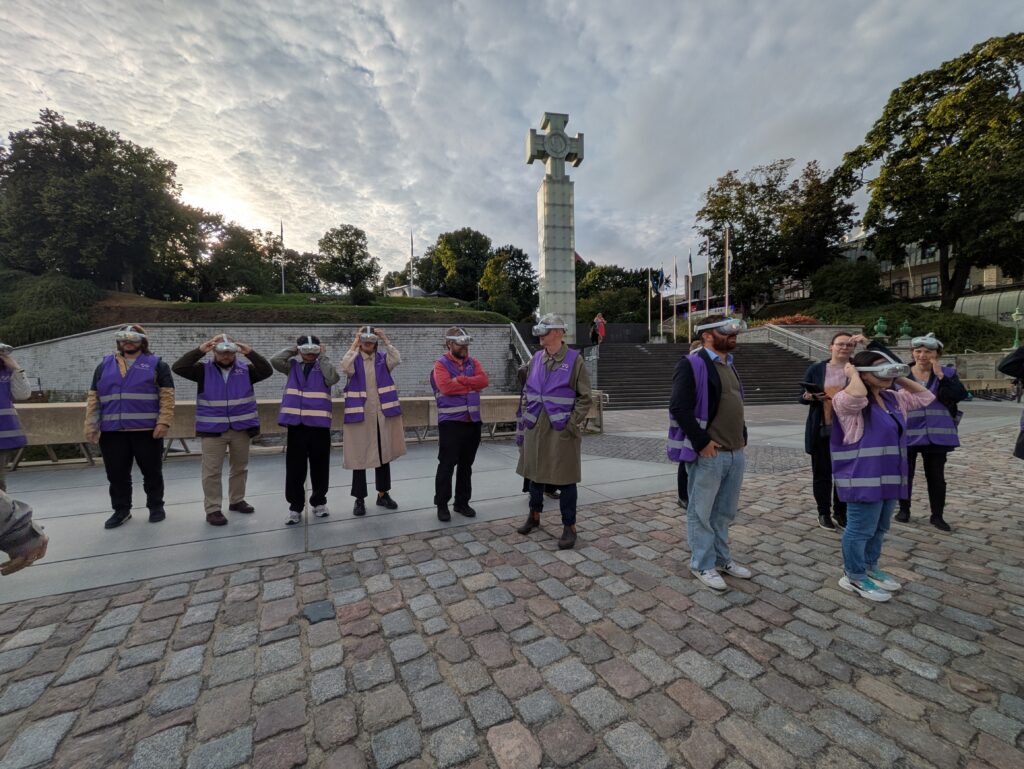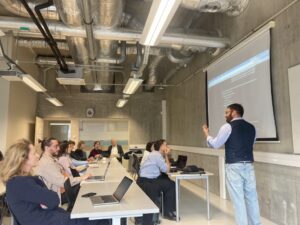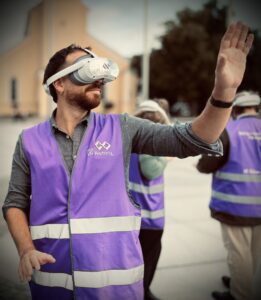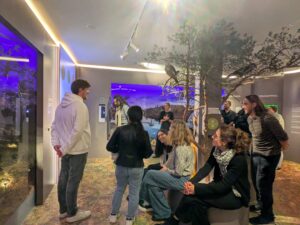 News
News
DIGHT-Net Report: Summer School in Digital Cultural Heritage: “(Re)Mediating the Past” August 27-29, 2025
September 4, 2025

From 27-29 August 2025, the DIGHT-Net project organised its first PhD Summer School in Digital Cultural Heritage. Hosted at Tallinn University, the school brought together participants representing 17 universities across Europe and beyond. In a truly interdisciplinary programme, consisting of lectures, workshops and site visits made possible by scholars from DIGHT-Net’s partner universities, the participants were familiarised with how digital technologies reshape our understanding of cultural memory, heritage practices and historical knowledge.
 On the Summer School’s first day, the participants were welcomed by Prof. Marek Tamm, after which Paolo Martinelli (University of Bologna) kicked off with a lecture on how cultural heritage is digitally remediated. Through four examples of how semiotic competences are delegated to technology, he intended to go beyond questions of what is lost in this process, instead probing the democratising and accessibility-enhancing capacities of human-machine interactions. In his subsequent workshop, he demonstrated how digital literacy and critical uses of generative AI can aid humanistic research by integrating ‘distant’ and ‘close’ methods of reading and writing.
On the Summer School’s first day, the participants were welcomed by Prof. Marek Tamm, after which Paolo Martinelli (University of Bologna) kicked off with a lecture on how cultural heritage is digitally remediated. Through four examples of how semiotic competences are delegated to technology, he intended to go beyond questions of what is lost in this process, instead probing the democratising and accessibility-enhancing capacities of human-machine interactions. In his subsequent workshop, he demonstrated how digital literacy and critical uses of generative AI can aid humanistic research by integrating ‘distant’ and ‘close’ methods of reading and writing.
Next, Chiara Piccoli (University of Amsterdam) provided a critical introduction into the new affordances of representing material heritage through 3D reconstructions, and the ethical, scholarly and societal challenges it poses. Drawing on projects such as the Amsterdam University Quarter and the Virtual Interiors Project, she exemplified how historical models can curate an argument about the past in three dimensions, serving as virtual laboratories and platforms for discussion. In her workshop, participants were encouraged to experiment with object-based digital storytelling for themselves by working on a 3D scholarly edition in the Voyager environment.
On the second day of the summer school, Asko Nivala (University of Turku) introduced the importance of space and geography in understanding cultural phenomena. Through geoparsing texts and collections, mapping spatial relationships within and across texts can elucidate how narratives shape and are shaped by geographical and geopolitical contexts. Through previous projects, including the “Atlas of Finnish Literature 1870-1940” and “Geoparsing the Corvey Collection,” he illustrated how spatial relationships can be mapped.
Consequently, Prof. Aldo Gangemi (University of Bologna) theorised the difficulties of encoding tacit, or implicit, knowledge, and how to address this using knowledge graphs. Through examples such as from the EU SPICE and ArCo projects, he laid out a frame-based ontology of perspectival pluralism.
In the afternoon, Prof. Filip Ginter (University of Turku) demonstrated the use of automated prompting of LLMs in preprocessing and analysing cultural heritage data. Filip argued that the prompt and the manner of interacting with LLMs matter, thereby demystifying the engagement with such models. On the other hand, he also concretized the use of LLMs in processing cultural heritage data, for instance demonstrating their value in correcting the machine-readable texts derived from performing Optical Character Recognition on manuscripts. In his workshop, the participants could experience automated prompting for themselves through practical exercises with DSPy in Colab.
Closing off the theoretical programme of the day, Prof. Indrek Ibrus (Tallinn University) presented his research on knowledge graphs as a methodology to study cultural and economic evolution. Drawing on a corpus of Estonian national media, the project links cultural data dispersed over different memory institutions, while testing the extent to which media plays a role in national innovation systems.
 After this lecture, the participants were able to experience how history can be digitally remediated in the virtual reality time-travelling experience VR Tallinn 1939/44. In this VR tour, the impact of the Second World War on Tallinn’s historical centre was made palpable, demonstrating how digital technologies can bring history alive in ethical and historically sensitive ways.
After this lecture, the participants were able to experience how history can be digitally remediated in the virtual reality time-travelling experience VR Tallinn 1939/44. In this VR tour, the impact of the Second World War on Tallinn’s historical centre was made palpable, demonstrating how digital technologies can bring history alive in ethical and historically sensitive ways.
On the Summer School’s last day, Prof. Julia Noordegraaf (University of Amsterdam) opened with a lecture on digital cultural heritage’s potential as a scalable approach to human culture. She argued that this scalability enables a zooming from micro to macro flows. Amongst others, she exemplified this scalability of digital heritage through the project Amsterdam Time Machine, a platform conceptualised to give access to the big data of the past. Such platforms of digitised cultural heritage allow for the experimental visualisation of historical, social and cultural data that may highlight how past human culture can be understood through digital methods and employed to address the challenges faced on contemporary cities and societies.
Following this lecture, the participating PhD students could get hands-on experience with digital methods in two more workshops. First, Asko Nivala led a geoparsing workshop, exemplifying how to implement named entity recognition and geocoding on a given text, to digitally map the spatial relations in texts. Thereafter, Julia Noordegraaf provided a workshop on the Dutch CLARIAH Media Suite, enabling the participants to explore Dutch audiovisual archival collections in a context of data criticism.
 After thus concluding the rich and stimulating theoretical programme of the Summer School, Marek Tamm led the PhD students and lecturers in a concluding group discussion. This allowed for reflections on the merit of the school’s programme for each student’s individual project, as well as on the future challenges and tentative directions of digital cultural heritage as a field of research. To top off this thought-provoking discussion, a last site visit to the Estonian Museum of Natural History provided practice-based insight on implementations of experimental digital solutions for knowledge transmission.
After thus concluding the rich and stimulating theoretical programme of the Summer School, Marek Tamm led the PhD students and lecturers in a concluding group discussion. This allowed for reflections on the merit of the school’s programme for each student’s individual project, as well as on the future challenges and tentative directions of digital cultural heritage as a field of research. To top off this thought-provoking discussion, a last site visit to the Estonian Museum of Natural History provided practice-based insight on implementations of experimental digital solutions for knowledge transmission.
We want to thank all lecturers and participants for their enthusiasm and collaboration. It was a pleasure to welcome this brilliant group to Tallinn University. We will draw inspiration from your critical insights into digital cultural heritage for DIGHT-Net’s future endeavours.
Marjolein Uittenbogaard
